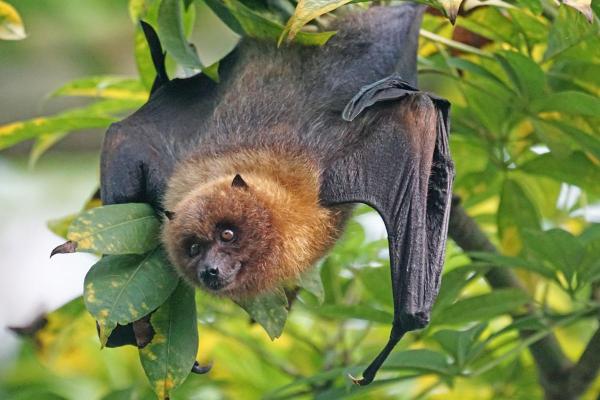How Long Do Bats Live?


When we think of small animals, we often expect short lifespans, but bats are an exceptional case. Many species of bats, despite their tiny size, can live remarkably long lives, sometimes reaching several decades. This longevity has fascinated scientists, leading to studies on why bats age so slowly compared to other mammals.
In this AnimalWised article, we’ll explore how long bats live, the factors that contribute to their longevity, and the unique physiological traits that allow them to live far longer than most small animals.
Why do bats live so long?
Bats show significant longevity for their size. While most small mammals live short lives, bats can live between 10 and 30 years in the wild. Some species, like Brandt's bat, can reach over 40 years despite weighing just a few grams. This lifespan draws attention from researchers.
Several biological adaptations support this longevity. In temperate regions, hibernation plays a key role. During winter, bats slow their metabolism. This reduces cellular damage and helps them save energy when food is scarce. Even during active times, bats have a slower metabolism compared to similarly sized mammals, which may reduce oxidative stress linked to aging.
Bats also have strong immune systems. They evolved as natural carriers of various viruses, leading to robust immune responses. These adaptations help protect against diseases and may prevent age-related issues that affect other mammals.
Life in the wild presents challenges that can cut a bat's lifespan. Bats face threats from predators, habitat loss, diseases, and climate change. The longest-lived species often have fewer predators and stable food sources. Their ability to fly helps them evade many ground threats. Scientists studying bats hope to find insights into aging that apply to humans. Their ability to live long lives in small bodies continues to intrigue researchers and may reveal important information about the biology of aging.
Ever wondered what makes bats mammals? Discover the fascinating traits that define these creatures in another piece you might find interesting.

What is the lifespan of a bat in captivity?
In captivity, bats often live longer than in the wild, as they avoid environmental threats and have steady food supplies and veterinary care. Under these conditions, some bats can live up to 50 years. Captivity protects them from predators, flight injuries, and diseases like rabies, which are often fatal in the wild.
However, captivity can affect some bats’ behavior and stress levels, especially in species that need large flight spaces to hunt. Bats with more passive behaviors and lower space needs, such as fruit bats, generally adapt well to captivity. In contrast, insect-eating bats and species that are fast flyers may experience more stress and shorter lifespans if they can’t meet their activity needs.
Did you know that bat reproduction has some unique traits? Find out more about their mating behaviors in another piece you might enjoy.
How long can a bat stay alive without eating?
Bats can go without food for varying lengths of time, depending on their metabolism and body fat reserves. During hibernation, many bats slow their metabolism drastically and can survive for 4–6 months on stored fat. In this period, they remain almost entirely inactive, which minimizes energy needs and helps them make it through times when food sources are scarce.
When not hibernating, bats can only go a few days without eating. Most species survive just 2–6 days without food before becoming weak, as they need a regular supply of energy for flying and regulating body temperature.
Fruit bats, which feed on fruits and nectar, tend to last longer without food than insect-eating bats, which need to eat regularly to support their high energy use.
Did you know there’s a common myth about bat vision? Uncover the truth in another fascinating read.
Life expectancy of a bat according to species
Bat lifespans show significant variation across species, with some capable of living for decades, aided by their unique physiology and ability to evade predators. Here’s a look at the life expectancies of different bat species, both in the wild and in captivity:
- Little Brown Bat (Myotis lucifugus): known for exceptional longevity, this species can live up to 40 years in the wild, one of the longest among bats.
- Egyptian Fruit Bat (Rousettus aegyptiacus): found across Africa and the Middle East, this fruit bat typically lives 15–25 years in the wild. In captivity, its lifespan may extend up to 30 years with proper care.
- Common Vampire Bat (Desmodus rotundus): native to Central and South America, these vampire bats have a wild lifespan ranging from 10 to 20 years.
- Townsend’s Big-Eared Bat (Corynorhinus townsendii): this North American species can live about 16 years in the wild, with individuals in captivity sometimes reaching 20 years.
- Hairy-Legged Myotis (Myotis keaysi): native to Central and South America, this species has a relatively shorter lifespan, typically living 6–10 years in the wild and up to 12 years in captivity.
- Western Barbastelle (Barbastella barbastellus): found across Europe, the barbastelle bat can live up to 23 years in the wild—long-lived for its size, though less so compared to species like the little brown bat.
- Madagascar Sucker-Footed Bat (Myzopoda aurita): this species, adapted to Madagascar’s warm and humid climates, has a life expectancy of about 8–10 years in the wild.
- Black Flying Fox (Pteropus alecto): known as the "flying fox," this large fruit bat inhabits Australia and Southeast Asia. It can live 15–20 years in the wild, while in captivity, with optimal care, it may reach up to 25 years.
Did you know that echolocation isn’t exclusive to bats? Explore the diverse animals that rely on this unique ability in our related article.

If you want to read similar articles to How Long Do Bats Live?, we recommend you visit our Facts about the animal kingdom category.
- Cooper, LN, Ansari, MY, Capshaw, G., Galazyuk, A., Lauer, AM, Moss, CF, ... & Orman, R. (2024). Bats as instructive animal models for studying longevity and aging. Annals of the New York Academy of Sciences .
- Gorbunova, V., Seluanov, A., & Kennedy, B.K. (2020). The world goes bats: living longer and tolerating viruses. Cell Metabolism , 32 (1), 31-43.
- Lagunas-Rangel, FA (2020). Why do bats live so long?—Possible molecular mechanisms. Biogerontology , 21 (1), 1-11.
- Munshi-South, J., & Wilkinson, G.S. (2010). Bats and birds: exceptional longevity despite high metabolic rates. Aging research reviews , 9 (1), 12-19.
- Wilkinson, G.S., & Adams, D.M. (2019). Recurrent evolution of extreme longevity in bats. Biology letters , 15 (4), 20180860.







